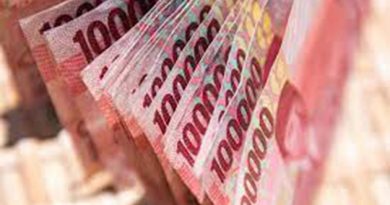Asian Currencies Hit by Stronger US Dollar, Indonesian Rupiah Slumps

All emerging Asian currencies weakened against a firming US dollar today, as comments by the US Federal Reserve chairman on the pace of rate hikes and a pick-up in US yields fuelled the greenback.
Treasury yields rose yesterday after Federal Reserve Chairman Jerome Powell said the Fed bank should continue to gradually raise rates.
The US dollar index against a group of six major currencies stood at 95.243 after rising to 95.299 overnight, its highest since mid-July 2017.
Among the regional currencies, the Taiwan dollar lost 0.2 per cent ahead of a monetary policy meeting later in the day. The Taiwan’s central bank is widely expected to keep its policy rate steady for an eighth straight quarter.
Thirteen of 17 analysts polled by Reuters said they expected the central bank to leave the benchmark discount rate
at 1.375 per cent. Four analysts predicted a 12.5 basis point rise to 1.5 per cent.
“Taiwan’s sovereign bonds and currency have held up well through the recent bout of emerging markets stress. This should not come as a surprise given Taiwan’s large current account surplus, substantial FX reserves and low level of government indebtedness,” DBS Bank strategists Philip Wee and Duncan Tan wrote in a note.
“As a result, the Taiwan central bank enjoys some level of flexibility in setting the timing and pace of policy normalisation.”
Indonesia’s rupiah weakened 1.23 per cent today as currency market opened for the first time since June 8 as traders returned from a series of public holidays.
The fall was despite Bank Indonesia saying on Tuesday that it was ready to defend the rupiah and respond to the US Federal Reserve’s interest rate increase with another hike of its own.
China’s yuan lost 0.27 per cent, with the central bank’s fixing rate set at its weakest in more than five months.
Malaysia’s ringgit was 0.15 per cent weaker, leaving it relatively untouched compared to regional peers.
The Singapore dollar and the South Korean won weakened 0.29 per cent and 0.41 per cent, respectively.
Thailand’s baht slid as much as 0.5 per cent today to touch its lowest since mid-November as the Bank of Thailand held rates steady yesterday.
Bank of Thailand Governor Veerathai Santiprabhob told reporters today that Thailand has a strong external position and the baht could withstand an impact from global trade protectionism.
Philippine peso
The Philippine peso slid 0.27 per cent to move closer to an 12-year intra-day low seen on Monday.
Today’s weakness came despite the Philippine central bank hiking rates for the second time in six weeks yesterday and saying it was ready to take further action to tame inflation and volatility in the peso.
The country is seeing significant outflows and its equity benchmark fell as much as 2 per cent today, setting it on its way to end a sixth straight session lower.
Indian rupee
he Indian rupee saw a 0.21 percent fall today after the minutes of the Reserve Bank of India’s (RBI) June policy meeting were released after market hours yesterday.
The minutes said RBI Deputy Governor Viral Acharya noted the bank’s monetary policy committee would keep a neutral stance because of “considerable uncertainties” around oil, food prices and trade tensions.
India’s country’s current account deficit is closely tied to oil prices. A sustained period of higher energy prices has the potential to increase food prices, speeding up inflation.
India’s chief economic adviser Arvind Subramanian said yesterday he was quitting his post to return to academic research in the United States.
courtasy : malaymail.com
photo : Financial Times
[social_warfare buttons = “Facebook, Pinterest, LinkedIn, Twitter, Total”]



